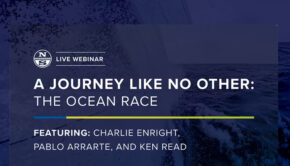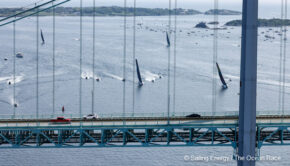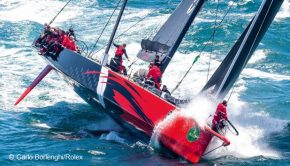KEN READ: Impressions of a skilled spectator
Published on April 11th, 2013
Now that the 2014-15 Volvo Ocean Race has revealed its schedule, Scuttlebutt sought the observations from a skilled spectator: Ken Read. After skippering entries in 2008-9 and 2011-12 editions, Ken will sit out the next race to focus on his new responsibilities as president of North Sails Group, but shares here his impressions…
After skippering the last two Volvo Ocean Races, it is not a shock to see that it is a commercially driven race course. Welcome to the commercially-driven world. To the cries of where has the traditional Whitbread route gone, unfortunately it seems to be gone forever for this race. It is what it is. To drive sponsors, particularly to have Volvo involved, the route will follow the commercial needs of the vested groups.
And sponsors are now a key component. The sport has changed, and the grand prix level is far more grand prix than it’s ever been. And grand prix costs money. Attracting the best sailors in the world is expensive. There are not a whole lot of people in this world that are sufficiently skilled to do this race, with fewer yet able to succeed in it. So these people get paid very well, and they should get paid very well. They are the best at what they do, and they are putting their lives on the line. This race is dangerous. So that aspect has gotten more expensive, and the cost of the boats continues to increase as well.
Another cost factor, and one of the things I am surprised about for this race, is that there are not fewer stopovers. One of the mandates has been to reduce costs, but this edition will have nine legs just like we had in the 2011-12 race. Now some of the stopovers will be what they call ‘pit stops’ where the boats are not hauled. That does help a little bit with costs, but doesn’t help a lot, and every time we have ever hauled our boat we found problems that needed to be fixed. So they better hope the new Volvo Open 65 is durable. This could prove to be interesting.
The aspect of the race that I am deeply surprised about is when the leg from Auckland to Itajai begins. For the 2011-12 race, we left Auckland on March 18, and that was deemed too late in the year to be in Southern Ocean. The chance for winter storms was just too great, and of course we know now what kind of boat-breaking conditions we faced. So when we completed that leg, it was a very strong suggestion from all of the participants last time that we need to leave Auckland earlier so that crossing is closer to the end of summer. But to see the 2014-15 race starting only three days earlier, my only recommendation to all the competitors is to buckle up boys and girls because they could be in for the ride of their life.
As for some of the leg changes, stopping Leg 1 in Recife, Brazil, rather than the traditional route to Cape Town, South Africa, is a bit of a shame. It has always been this long, dynamic leg, fast across the south; it’s just a classic. From a sailor’s standpoint, the city of Cape Town was always a highlight of the race. Commercially the stop was not as good as some of the others, but the sailors loved it and so did their families. So losing that stop is a casualty.
Interestingly, the strategy for Leg 1 to Recife could be quite similar as the last race. To avert the South Atlantic High, the course had taken us to the west where we rounded the islands of Fernando de Noronha off the Brazilian coast. So the route now, instead of turning at the islands and heading south, will now just extend a few hundred miles further to the southwest for the finish. Other than dealing with the doldrums, it should be a relatively easy leg.
So the change to Leg 1, followed by the really long Leg 2 from Recife to Abu Dhabi, is my dominant race route surprise. This second leg is not going to be easy. With routing software, the time to be complete this leg could be a week longer or a week shorter than the plan. There is a lot of upwind once you turn the corner and head north, and there can be a lot of light air. It could be dreadfully light, and this pattern can extend all the way into the Gulf of Oman. The predictability of the breeze, particularly north of the equator, is very difficult.
So Leg 2 will be a hard one to plan for, and will be particularly hard on the crews. You have to plan for plenty of heavy air, as you most likely will head south toward the roaring forties, lock into a good front, and hop on the train toward the tip of Africa. You have to be prepared for the cold, the big breeze and breakages during this section, but then you head north and you quite possibly will get the opposite. How these boats get moded for the different conditions, and how each team sets up their boat for this leg, will be very telling. The first half could be very hard running conditions with the second half being light air beating.
The 2011-12 edition had leg 2 extend from Cape Town to Abu Dhabi, which then was later modified with the secret shuttle service to avert any problems with piracy. Their plan this time is to race through the Arabian Sea without interruption, and I can only assume they have done their homework to assure that the region is now sufficiently safe. Without being able to race the full distance, I don’t think they would have had Abu Dhabi as a stopover in the next race.
The changes to the rest of the race are nominal, and while I am thrilled that the U.S. stop will be in my hometown of Newport in May, it will present significant challenges to the teams. The teams will deal with the cold fronts coming off the east coast in their approach, and then the route to Europe will head north and hook into cold fronts that are still pumping. We can’t forget the 2005-6 edition, and how that devastating leg originated in New York (one death, one sunken boat). Leaving from Newport is much the same, so that could be a messy leg.
So when you have rounded Cape Horn in the next edition, and you think you have the worst of it now behind you, don’t forget about the approach to Newport, and the transatlantic crossing, as they can be pretty brutal too.
2014-15 Volvo Ocean Race
Leg 1: October 11, 2014 – Alicante, Spain to Recife, Brazil – 3,421 nm
Leg 2: November 9, 2014 – Recife, Brazil to Abu Dhabi, UAE – 9,707 nm
Leg 3: January 3, 2015 – Abu Dhabi, UAE to Sanya, China – 4,670 nm
Leg 4: February 8, 2015 – Sanya, China to Auckland, NZL – 5,264 nm
Leg 5: March 15, 2015 – Auckland, NZL to Itajaí, Brazil – 6,776 nm
Leg 6: April 19, 2015 – Itajaí, Brazil to Newport, USA – 5,010 nm
Leg 7: May 17, 2015 – Newport, USA to Lisbon, Portugal – 2,800 nm
Leg 8: June 7, 2015 – Lisbon, Portugal to Lorient, France – 647 nm
Leg 9: To be decided – Lorient, France to Gothenburg, Sweden – 1,600 nm
2011-12 Volvo Ocean Race
Leg 1: November 5, 2011 – Alicante, Spain to Cape Town, South Africa – 6,500 nm
Leg 2: December 11, 2011 – Cape Town, South Africa to Abu Dhabi, UAE – 5,430 nm
Leg 3: January 22, 2011 – Abu Dhabi, UAE to Sanya, China – 4,600 nm
Leg 4: February 19, 2012 – Sanya, China to Auckland, New Zealand – 5,220 nm
Leg 5: March 18, 2012 – Auckland, New Zealand to Itajai, Brasil – 6,705 nm
Leg 6: April 22, 2012 – Itajai, Brasil to Miami, USA – 4,800 nm
Leg 7: May 20, 2012 – Miami, USA to Lisbon, Portugal – 3,590 nm
Leg 8: June 10, 2012 – Lisbon, Portugal to Lorient, France – 1,940 nm
Leg 9: July 1, 2012 – Lorient, France to Galway, Ireland – 485 nm








 We’ll keep your information safe.
We’ll keep your information safe.